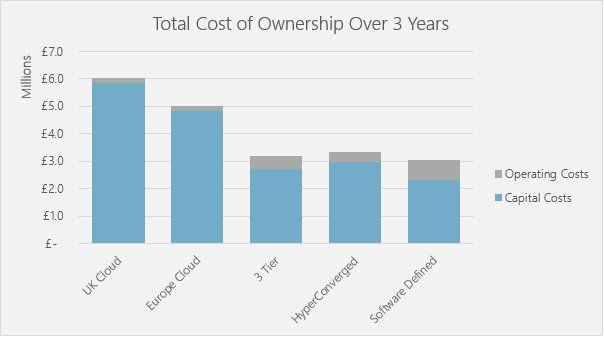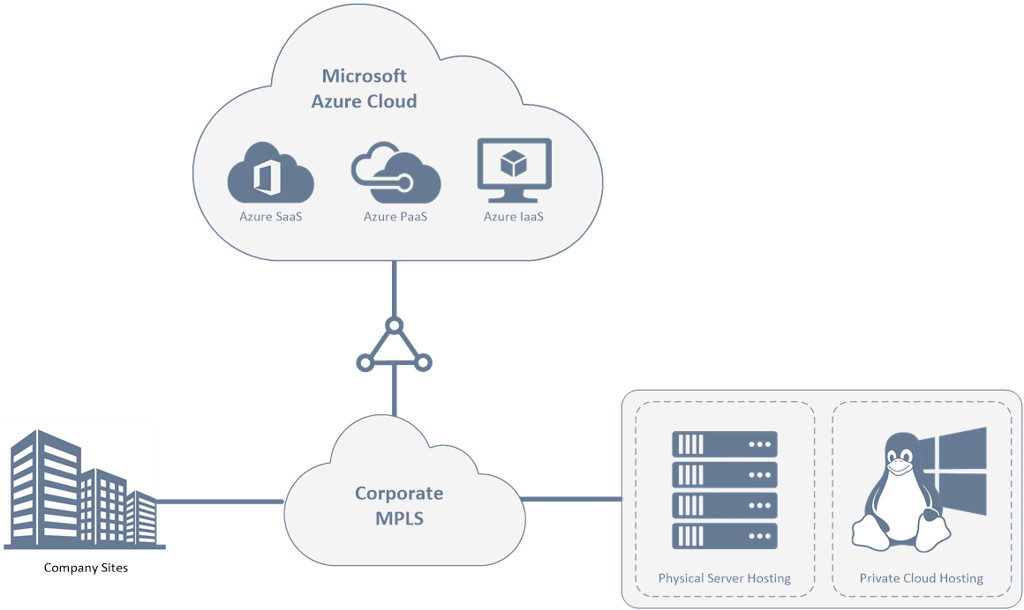The public cloud has been mainstream for over 10 years, and during this time most businesses have used the public cloud - in some form - due to its easy and fast-to-deploy nature.
However, as these environments have matured, businesses have come up against the issue of cloud sprawl. Many customers have looked at using private cloud in the past, but the cost and complexity associated with deploying such an environment has precluded them from it.With the advances that have been made recently with private and hybrid cloud technologies, this is no longer the case. Deploying an on-premise hybrid cloud can be as simple as a few clicks!
Ultima has decided to take a closer look at the costings of public cloud and on-premise IT, with some interesting results. We wanted to explore a range of platforms that a business could use, to allow a true comparison. The five scenarios we looked at are:
- Fully Public Cloud Hosted in a UK Based Public Cloud
- Fully Public Cloud Hosted in a European Public Cloud
- Enterprise Private Cloud Based on a 3 Tier Architecture (Compute, Networking and Storage)
- Enterprise Private Cloud Based on Hyper Converged Appliances
- Software Defined Infrastructure Based on Non-Resilient Hardware

To provide the best costings in the public cloud, we have opted to use pre-paid compute which is, on average, 30% cheaper than using the pay-as-you-go model. With this model, you are committed to spending a monthly amount and there is no benefit reducing your utilisation. Think of it like an enterprise mobile contract; you can either opt for pay-as-you-go which costs a little more - but pay for exactly what you use - or you can pay monthly and benefit from a cheaper fixed cost, but if you don’t use it you lose it.
In order to ensure the comparison was as fair as possible, all of the cloud instances are not auto-scaling and are always on. This is not the most efficient way of migrating to the public cloud, however it does demonstrate what the costings would be for a “lift and shift” migration to the public cloud - without considering some of the benefits you could gain from optimising your workloads for the public cloud.
For the on-premise infrastructure, we have designed it to be resilient with at least N+1 redundancy in all components within the infrastructure, except in the software defined where we are using single power supplies. This means that this infrastructure will have the level of availability that an enterprise would expect.
The table below illustrates the relative increase or decrease in cost for each option in comparison:

If you simply look at the numbers, on-premise seems like the clear winner. However, to only look at the cost would be misleading - public cloud has a huge amount of benefit when deployed and consumed correctly.
Public cloud has a near infinite scalability instantaneously, something which an on-premise infrastructure just can’t offer. For workloads that are swiftly growing and shrinking - such as web front ends for online retailers, or encoding instances for online video streaming - having a platform that can rapidly grow, on demand, can lower the time to value for the business, and offer a competitive advantage.
In order to use the public cloud in a scalable manner, it is key that customers re-architect the applications they want to scale, to be cloud native. Without re-architecting there is little-to-no benefit of moving out of the public cloud, and only a vast amount of risk.
As part of this, we have not looked at Platform as a Service (PaaS) or Software as a Service (SaaS) offerings. Again, this was to keep the comparison as like-for-like as possible, however, when it comes to a real world deployment of public cloud, both of these offerings are likely to be considered - if not used. In order to utilise these services, application re-architecture will need to take place.

Ultima believes there are four main factors that will define where a business should choose to put each workload:
- Cost
- Performance
- Scalability
- Data Control
There is no simple answer to this, therefore for most businesses it calls for a hybrid cloud setup - with some workloads sat in the public cloud, whilst some reside within the corporate data centre.
Management is imperative when using a hybrid set up - otherwise the end result is two, independent, segregated environments which don’t allow you to fully gain the benefits of using both services. There are a variety of options - depending on your vendor of choice - from VMware’s vRealize suite, to Azure Pack from Microsoft - including Open Source if that’s what you are after.
Ultima offers a variety of services that can help you choose the right path for your infrastructure; from Data Centre Optimisation which provides a strategic view of your data centre strategy, to a fully Managed Cloud Platform formed of Infrastructure as a Service (IaaS), PaaS and SaaS services - or a review of how to provide a Unified Storage platform for your business to gain insight and value from.
There has been a lot of interest around Azure Stack, as this will give a unified management interface for both on-premise and public cloud management, with a cloud-like per-VM consumption model for both environments. You can stay informed with updates from Ultima as the release gets closer.
Please Note - The figures used are based on the following assumptions:
- 600 virtual machines
- Each virtual machine having 4 cores, 16GB of RAM and 300GB of storage
- All storage for the VM’s must be all flash
- N+1 redundancy is required as a minimum in all environments
- Disaster recovery costs are not included
- Backup costs are not included
- Security costs (such as firewalls) are not included
- The on-premise solutions are built on 10Gb networking as a minimum


